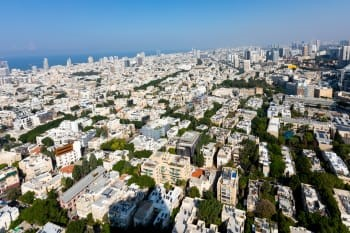Adi Cohen, themarker.com
A decade after the Tel Aviv municipality approved a conservation plan in its area, which includes about 1,000 buildings and sites, and in the light of ongoing legal battles between it and hundreds of property owners in the city - the municipality appears to be on the way to a loss. The Tel Aviv District Compensation Appeal Committee and Reconciliation Taxes, which should decide whether a preservation building is undervaluing or impairing the value of an asset, has recently revealed its official position that the municipality is not eligible for the improvement levy under the conservation plan.
The implication of this position is dramatic: According to the committee's position, the improvement levies that the municipality requires from property owners in preservation buildings, estimated at NIS 1 billion - it will not be able to charge. At the same time, compensation claims from property owners amount to NIS 2.5 billion.
The committee's position, which has not yet published its official decision, was first presented at a hearing held in late November by committee chairman Binyamin Zalmanovich: "We believe there is no place, legal and legal, to charge for Plan 2650 (Tel Aviv Conservation Plan; K) In the levy of praise. "
The Tel Aviv Municipality's conservation plan, approved in 2008, includes more than 1,000 buildings designated for preservation, of which about 200 are for strict preservation (conservation subject to strict restrictions, including the prohibition of any additional construction).
Zalmanovich emphasized that the position of the committee, which will be explained in more detail at the time of the decision, was dissociated from the expert opinion of the committee, published several weeks earlier, and after the positions of all parties were heard. "Even without the expert's opinion, after we have debated and discussed and heard and learned all the materials and all the appraisers - both of the assessors of the local committee and of the decisive appraisers - we think that there is no charge for the improvement levy for the program," he ruled. The chairman of the committee also referred to the complexity of the procedure and the fact that there have been dozens of discussions about the municipal conservation plan so far: "This is probably the last step in this complex case," he ruled.
Improvement or decrease in asset value?
The debate over whether an urban conservation plan is bringing property improvements - or, alternatively, reducing their value - has been at the root of the legal and appraisal controversy that has been on the appeal committee's table for nearly a decade. The decision on the issue, which is due by April, is a decision in principle. Experts estimate that apart from its effect on Tel Aviv and the boundaries of the district under the jurisdiction of the Appeals Committee, the decision is expected to affect other local authorities, including non-provincial authorities.

Tel Aviv, Panorama 2019 Photo: Eyal Toag
Once the plan was approved, the dispute between the municipality and the property owners emerged. Over the years, hundreds of claims have been filed against the municipality on behalf of property owners in the city: these claimed that due to the building restrictions under the plan, the value of the properties would decline, and that they would have to bear high costs of renovation and maintenance, as part of the plan's provisions. However, the municipality has outright rejected the compensation claims, claiming that the plan not only does not detract from their value, but even improves it. According to the municipality's method, a preservation program improves properties by bringing them to a brand and uniqueness, thus increasing their value in the real estate market.
On the basis of the municipality's position, some 400 demands for payment of a betterment levy were sent to property owners included in the plan, at an average height of between NIS 200,000 per housing unit and up to NIS 1-2 million for entire residential buildings.
According to a report from the Tel Aviv Municipality's auditor, the vast majority of property owners challenged the payment requirement, and as of 2018, out of about 104 crucial assessments received as part of these appeals - the vast majority ceased to be at the municipality's discretion and set much lower amounts than what was determined in the municipal assessment. Moreover, in some cases, the appraisers have determined that the municipality is not entitled to payment at all.
Property owners against the municipality of Tel Aviv
The Tel Aviv Municipality's troubles do not end with the issue of improvement levies: There are some 380 property compensation claims pending against the municipality, claiming impairment due to building restrictions imposed by the plan on their assets, including limiting the possibility of realizing urban renewal plans in these buildings. In their claims, property owners also addressed the high renovation and maintenance costs required by the plan.
The Appeals Committee has appointed architect Moshe Shapiro to examine the level of financial damage to property owners. Shapiro's findings, filed in October, show that the cost of renovating a building is indeed far higher than the cost of renovating a standard building (a gap of about NIS 1,250-1,330 per square meter). Shapira's opinion in his opinion was much higher than the gap presented by the local committee in Tel Aviv at the hearing. (NIS 900-1,000 per square meter only).
Adv. Anat Byrne, who represents many property owners in compensation claims against the municipality, notes: "Initially, the improvement levies were a kind of creative contraption that the municipality initiated to deal with the many claims filed against it for the decline in the value of the conservation plan. We have been participating in appeals committee hearings for years and represent dozens of clients who have been waiting a long time for a decision, after their rights have been violated due to the conservation plan.
"It is gratifying to see that the protocol has finally been told that no improvement levy should be charged for the conservation plan. This is an opportunity for the local committee to open the door to practical solutions that will allow property owners to exercise their rights and preserve the buildings, rather than having to spend years in legal proceedings."

Adv. Anat Biran Photo: Eyal Toag
Real estate appraiser Yael Rosenberg-Chechik of Camille Tarshansky Raphael's office reinforces the following: "An urban preservation plan is considered a restrictive plan, by which it does not apparently value the apartment even under the effect of branding the property, as part of the building intended for preservation. The sale of apartments included in the urban outline plan for the preservation of buildings and sites in Tel Aviv compared to apartments not included in the plan, in the very same space, in the heart of the city, found that not only is there no difference in value per square meter between apartments, but that the value of apartments outside the conservation plan is higher. The improvement, thanks to the concept of branding that enables retention, was invented by the local committee as a tool for prosecution for impairment filed against it. "
The Tel Aviv Municipality commented: "First, we note that the Appeals Committee has not yet made any decisions regarding improvement by virtue of the conservation plan. When decisions are made, they will be taught by all involved - applicants and local committee representatives. Assets, and the local committee charges the owners with a betterment levy accordingly. This position has been confirmed in crucial assessments, and in many cases a betterment levy has been paid on the conservation plan. "



